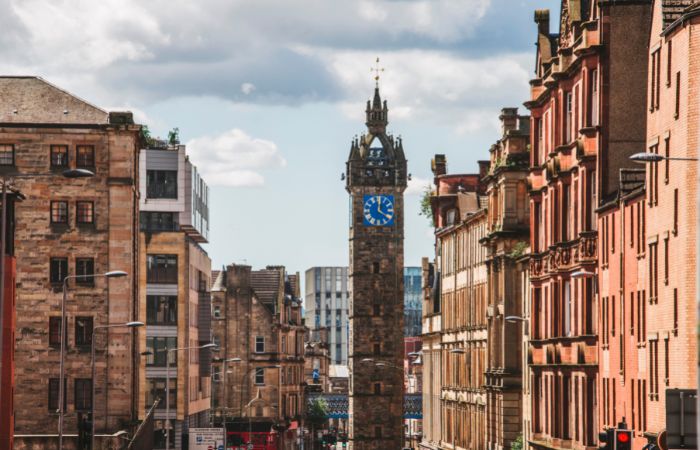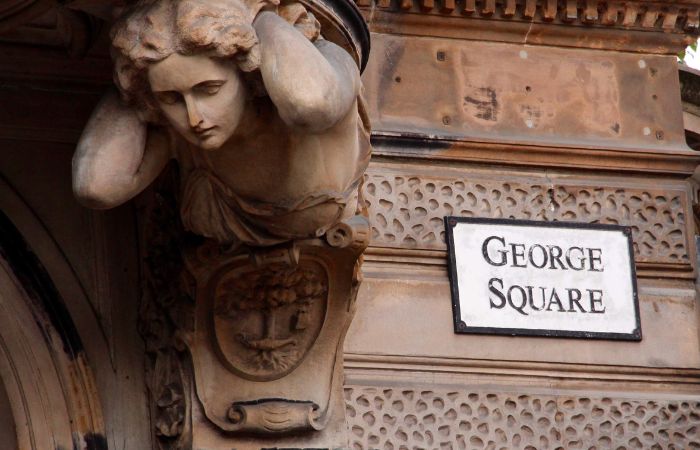Top 23 Things Glasgow is Known For & Famous For
Arguably Scotland’s most culturally-rich city, Glasgow is teeming with restaurants and pubs, art galleries, museums, music festivals, and historic buildings that go as far back as the 11th century. Outsiders often describe the city as more rugged than refined, but its quirks and flaws only seem to strengthen its character and make it that much more interesting.
Glasgow is famous for its animated population, peculiar accents, and stunning architecture. Achievements in art, sports, music, and shipbuilding decorate the city’s most recent history. Among other things, Glasgow is a city known for drinking and creating interesting experiences.
Read on to learn more about one of Scotland’s most unique features and locations.
Disclaimer: This post may contain affiliate links. We may earn a small commission for purchases made through links in this post, at no extra cost to you.

Friendly People
Glasgow regularly appears on lists of friendly cities and even topped this Rough Guides list of the friendliest cities in the world.
Known for their colorful personalities and down-to-earth qualities, Glasgow residents are sure to make an impression. As a port city with a history of immigrants, newcomers are always welcome. People tend to be very welcoming and comfortable around visitors, almost to a fault, as critics of the city might judge residents on their bluntness.
Glasgow also gets a bad rap for being violent, which could be attributed to the prevalence of pubs and the intense drinking culture. Regardless, the city still manages to charm and have a lasting impression on many of its visitors.
Distinct Accents
Visitors and Scotland natives will notice a distinct shift in accents when arriving in Glasgow. The dialect seems to have a variety of influences and nuances that are even an area of study for many professors and language experts.
Nicknamed “Glaswegian” or “Glasgow patter,” the evolving accent seems to have Irish and Scottish Highland influences from immigrants that arrived early on. Some people also suspect a Cockney influence that may have spread from certain London television shows.
Common features of the dialect include t-glottalization, th-fronting, and dentalization, among other subtleties.

Architecture
Glasgow’s architectural feats are some of the most impressive in Scotland, and the city takes pride in preserving many of its historic buildings. Glasgow’s oldest building, The Glasgow Cathedral, dates all the way back to medieval times, and it’s the oldest Cathedral in Scotland.
However, many of the most stunning visuals come from the abundance of Victorian-era architecture. The Glasgow City Chambers, for example, houses the municipal government and contains some of the most impressive and elegant architectural features in the city.
Other examples include:
- The Tolbooth Steeple
- People’s Palace and Winter Garden
- Templeton Carpet Factory
- St. Vincent Street Church
- The Lighthouse
- University of Glasgow
The city was also home to Scotland’s most celebrated architect, Charles Rennie Mackintosh, who was responsible for a lot of Glasgow’s buildings from the late 1800s to the early 1900s.

George Square
Named after King George III, George Square is one of Glasgow’s many public squares featuring some of its most prominent buildings and statues. It is also the site of many of the city’s ceremonies and celebrations. There’s even a webcam at the square so that you can see what’s going on.

Glasgow Cathedral and Necropolis
The Glasgow Cathedral is the oldest building in the city, dating back to 1197, and one of the only remaining medieval-style buildings in town. The building still functions as a church and is one of the city’s many protected or “listed” buildings.
To the East of the Cathedral is the city’s Necropolis, an enormous burial site for individuals from the last 200 years. Over 50,000 people have been buried at this site, and there are all sorts of impressive monuments dedicated to important people.

Kelvingrove Art Gallery and Museum
The Kelvingrove Art Gallery and Museum boasts some of the most impressive displays in the United Kingdom. Not only is the building itself visually striking inside and out, but it also features some of the most fascinating exhibits in Scotland.
Kelvingrove contains everything from priceless art pieces to dinosaur bones, as well as elements of human history and natural history. Best of all, the museum and gallery are free to enter, making this one of the most popular attractions in the city.

The Old Firm
The Celtics and the Rangers are two of Scotland’s premier football organizations. Both are based in Glasgow, and they are collectively known as “The Old Firm.”
The two teams have a highly intense professional rivalry with political, religious, and cultural disagreements woven in between. The Celtic’s stadium is also the largest in Scotland, and rival games tend to be major events that can get pretty heated.
Regardless, Glasgow residents love their football, and if you love high-energy sporting events and rowdy gatherings, Glasgow is a great place to find them.

Haggis
Haggis is the national dish of Scotland, and there’s no shortage of restaurants that serve it. While technically classified as a pudding, this is a meat-based dish that traditionally contains lamb heart, liver, and lungs, as well as some beef. Most recipes include oatmeal and a variety of seasonings, including cayenne pepper and onion.
Traditionally Haggis is served in a sheep’s stomach, but modern recipes may substitute this with something else. Importing sheep lungs is also illegal in the United States, so Glasgow is one of the best places to get an authentic Haggis dish.

Scotch Pie
Scotch pie is another staple dish in Glasgow and Scotland as a whole. This is another meat-based dish, mostly containing mutton. Traditionally, Scotch pies are double-crusted and very firm, making them easy to eat with one hand. Other ingredients include eggs, mashed potatoes, and baked beans, but the recipe is customizable.
These are commonly served at football games, but the recipe goes back several hundred years in Scottish history.

The Glasgow Mural Trail
Embracing its many talented street artists, Glasgow established the Mural trail, which features enormous artworks and paintings covering entire sides of buildings and shops. This is a recent attraction that began development in the early 2000s and draws many local and outside visitors. The murals pay tribute to historical figures, celebrities, and Glasgow residents.

Shipbuilding
Glasgow’s location on the River Clyde made the city a perfect spot for both shipping and shipbuilding.
Glasgow used to have a considerable shipbuilding industry and would manufacture everything from yachts to naval ships for people around the world. Ships from this area were renowned for their quality.
While the shipbuilding industry in Glasgow has mostly died out, you will still find museums and other tributes to the times.

Scotland’s Women’s Only Library
Dedicated to women and feminist ideals, the Women’s Library is a library, museum, and charity in Glasgow that is open to the public. The site serves as a celebration of Scotland’s women and women around the world, featuring all sorts of great history surrounding women’s lives and achievements.

Glasgow Subway System
The Glasgow Subway System is somewhat of a quaint, underground metro system deeply connected to the city’s history.
This system consists of two subway cars that run in a loop. One car runs clockwise, and the other loops the city counterclockwise. Thanks to this and its original orange color scheme, the subway got the nickname “The Clockwork Orange.” Glasgow’s subway is a light metro system that retains many of its vintage qualities while adapting to modern trends.
From enabling residents to get around the city quickly to allowing college students to hop from pub to pub for a pint, the metro is an important part of the city’s heritage.
Here’s a brief YouTube video showing the subway in action:

The Arlington Baths – World’s Oldest Swimming Club
Another addition to Glasgow’s rich history is the Arlington Baths Club, the oldest swimming club in the world.
The club dates back to the 1800s and still operates out of the same building, which has a lot of the original Victorian architecture. Like many buildings in Glasgow, the Baths Club building is a Grade-A listed building. Inside, you’ll find a skylit pool, exercise facilities, and all sorts of relaxing amenities like saunas and hot tubs.
Here’s another YouTube video that takes you through the club:

The Kelvin Scale
The Kelvin Scale is an internationally-recognized temperature scale developed by William Thompson, otherwise known as Lord Kelvin. Glasgow is famous for being the city in which Lord Kelvin discovered this scale.
While Lord Kelvin wasn’t born in Glasgow, he moved to Glasgow as a young adult and attended Glasgow University, and the city became his permanent residence. He was an engineer, a professor, and eventually Chancellor of the university. Today, you can find an exhibit dedicated to his work at the University’s museum.
Host of the First Official International Football Match
Glasgow is also known for hosting the world’s very first international football game on November 30, 1872. Scotland and England faced off against each other at the Hamilton Crescent Cricket Club field in Patrick, Glasgow. The final score of the game was 0-0.
Many Gaelic Speakers
Glasgow is known for having a relatively large population of Gaelic speakers. Scottish Gaelic is an old, Celtic language native to Scotland that is mostly dying out. UNESCO placed Gaelic on a list of endangered languages, as there are only tens of thousands of people known to speak it at all.
While there are relatively few people speaking Scottish Gaelic, Glasgow stands out for having a concentrated population of speakers.

The Kingston Bridge
Glasgow’s Kingston Bridge is not only an impressive piece of modern architecture in the city, but it’s also one of the busiest bridges in the entire continent of Europe.
The Kingston Bridge created some much-needed traffic relief at the time of its construction in the 1960s. The designers had the foresight to consider projected increases in traffic for the following decades so that the bridge would still serve its original purpose for years to come.
Today, the 267m (879 ft) bridge that crosses the famous River Clyde sees over 120,000 vehicles every day, and its age and architectural significance make it eligible for listed status.
Mr. John Logie Baird – Invented the First Television
Glasgow is famous for playing a crucial role in the invention of the television after being a temporary home for its inventor, John Logie Baird.
Baird is a Scottish-born inventor and engineer, and like Lord Kelvin, John Baird also attended the University of Glasgow. This is where the idea was born, and Baird later debuted his invention in London. As the technology spread, he was later beaten by competitors.

Whisky
Glasgow is also known for being somewhat of a hub for whisky, including Scotch and some Irish whisky. Historically, the city played a vital role in the transport of whisky due to its location on the River Clyde. Boats were also exempt from certain prohibition rules in the 1800s, and there were many floating pubs that traveled on the river.
Not to mention, Glasgow is known for having world-famous pubs and distilleries, and the nightlife in the city is known to be very lively.

A Strong Drinking Culture
Glasgow’s drinking culture is one of both fame and infamy.
The city is known for its vibrant nightlife and impressive network of pubs, and drinking seems to be a shared theme across all groups, regardless of age or economic status. There’s no shortage of fun and interesting stops for visitors and social drinkers.
However, the city’s drinking culture runs deeper than people just having a few beers on a night out, and there are legitimate concerns about alcoholism in the city.
The city was known for its heavy drinkers prior to the COVID-19 pandemic, which research suggests increased the problem. The government is increasingly taking measures to try and curb alcoholism.
Hyndland Conservation Area
Glasgow is known for taking pride in its heritage areas and for putting a lot of effort into preserving its older buildings. Conservation areas are protected areas in the city, and in particular, the Hyndland area contains a lot of Victorian-era tenements, including apartment buildings and townhouses.
The conservation area deems many of the buildings as historically or architecturally significant, which protects them from development and construction.
Many of these buildings are also eligible for government grants, which aim to fund repairs and necessary upkeep of the properties to keep them in their original condition. People often praise Glasgow for its efforts in protecting the history and the environment in its conservation areas.
UNESCO’s City of Music
UNESCO is an organization that specializes in connecting the world through culture, education, science, and art.
Their City of Music program aims to build a network of cities with remarkable music scenes, and in 2008, Glasgow was one of the first cities added to the list.
Glasgow is known for producing world-famous bands, including Franz Ferdinand, Mogwai, Chvrches, and The Fratellis. The city hosts music awards, puts on thousands of music festivals every year, and provides great accessibility to music education, performances, and opportunities. These achievements earned the city UNESCO’s mark of musical excellence.

Conclusion
From top-notch naval ships in the early 1800s to world-famous rock bands of the 2000s, Glasgow has undoubtedly made its mark on history. Today, the city still impresses visitors with its architecture, friendly and outgoing citizens, and widespread music scene that earned it a spot on UNESCO’s Cities of Music list.
While no city is without its faults–and Glasgow definitely has a few–the city still continues to prove itself as a hotspot for entertainment, history, and interesting experiences.
Disclaimer: The below text contains affiliate links. We may earn a commission for purchases made through links in this post, at no extra clost to you.
– Booking Resources –
– Plan Your Trip with Confidence! –
Viator – Discover and book a diverse array of curated tours and activities worldwide through Viator’s platform, connecting travelers with authentic experiences crafted by local experts.
See what tours Viator currently has to offer here.
Viator also offers virtual tours here.
Tours4Fun – Explore a wide selection of handpicked tours, attractions, and vacation packages globally, connecting adventurers to enriching travel experiences designed by local insiders. Find your next adventure with Tours4Fun here.
Hostelworld – Unlock a world of budget-friendly accommodation options with HostelWorld, your gateway to a global network of hostels and budget stays, ensuring affordable and convenient stays for travelers around the world. Find accommodation for your travels on Hostelworld here.
World Nomads – Protect your adventures with World Nomads. Comprehensive travel insurance for every traveler. Get coverage that travels with you, wherever your wanderlust leads. Get an insurance quote with World Nomads here.
